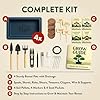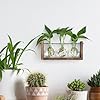Chia Pet The Simpsons - Homer with Seed Pack, Decorative Pottery Planter, Easy to Do and Fun to Grow, Novelty Gift, Perfect for Any Occasion
$19.97 (as of December 20, 2025 02:33 GMT +00:00 - More infoProduct prices and availability are accurate as of the date/time indicated and are subject to change. Any price and availability information displayed on [relevant Amazon Site(s), as applicable] at the time of purchase will apply to the purchase of this product.)HOME GROWN Bonsai Tree Starter Kit – Unique Christmas Gift for Adults, Men, Women - Grow 4 Bonsais – DIY Crafts Hobby Gardening Kit for Plant Lovers, Mom, Dad - White Elephant Gifts for Adults
25% OffThe cold, dry months of winter can be tough on indoor houseplants. Changes in sunlight, humidity, and temperature from the summer months can lead to stressed, unhealthy plants if proper care is not given.
This comprehensive guide will teach you how to care for all your indoor plants through the winter season. You’ll learn winter-specific care, troubleshooting, and tips to keep your indoor garden thriving when the temperatures drop outside.
Here’s what we’ll cover:
- Understanding how winter weather impacts plants
- Adjusting key factors like light, water, humidity, and fertilizer
- Winter care tips for popular indoor plant varieties
- Troubleshooting common winter plant problems
- Techniques to promote flowering and growth
- Ideas for using grow lights and heat sources
- FAQs on protecting plants from drafts, grow lights, humidity, and more
Follow these tips to ensure your precious leafy friends stay healthy and flourishing despite winter’s harsh effects. Your plants will bounce back even stronger when spring arrives again.
How Winter Weather Impacts Indoor Plants
While our houseplants reside indoors protected from the elements, shifts in outdoor conditions can still impact their care needs. Here are key effects of winter:
Lower Light Levels
Shorter days and weaker sun mean plants receive less natural light from windows. Supplemental lighting may be needed.
Lower Humidity
Heaters running indoors reduce humidity levels that plants thrive in. Misting and pebble trays can help boost moisture.
Temperature Fluctuations
Frigid nights followed by daytime warmth from heating systems stresses plants. Maintain consistent comfortable temps.
Reduced Water Needs
Cooler, darker days mean plants grow and drink water slower. Take care not to overwater in winter.
Delayed Fertilizing
Most plants don’t need much fertilizer over winter when growing slowly. Resume in spring.
With preparation and adjusted care, you can help indoor plants survive and stay healthy through harsh winter conditions.
Adjusting Key Winter Care Factors

Caring for indoor plants in winter revolves around optimizing several key factors. Here are tips for providing light, water, humidity, and temperature through the colder months:
Providing Sufficient Light
- Place plants as close to bright windows as possible without risking cold drafts from glass.
- Rotate plants weekly so all sides receive equal sun exposure.
- Add grow lights to supplement natural light on darker days.
- Clean windows and wipe dust from leaves to maximize light absorption.
Watering Properly
- Allow soil to dry out further between waterings. Test with finger to check moisture depth.
- When watering, be thorough to saturate entire root zone until water drains from holes.
- Mist leaves occasionally to provide extra moisture for tropical varieties.
- Remove yellow, crispy leaves to reduce water demand and encourage new growth.
Boosting Humidity
- Run humidifiers to maintain ideal 40-60% humidity for tropical plants.
- Place gravel trays filled with water beneath plants so the evaporating moisture increases local humidity.
- Mist plants daily focusing on the underside of leaves where pores breathe.
Regulating Temperature
- Move plants away from drafty areas near doors, windows, or vents.
- Avoid overheating rooms. Keep indoor temperatures under 80°F during the day for most plants.
- Prevent rapid temperature shifts between night and day. Maintain consistent warmth.
Following these adjusted care practices will keep plants thriving through harsh winter conditions. Next we’ll look at tips for specific varieties.
Winter Care for Popular Indoor Plant Types
Certain indoor plants have particular vulnerabilities or care needs over winter. Use these tips to safeguard specific varieties in your collection through the colder months:
Succulents
- Allow more time between waterings, waiting until soil is completely dry.
- Slow down feeding to every 2-3 months.
- Keep above 50°F to prevent full dormancy and shriveled appearance.
Orchids
- Water only when media turns dry, allowing thirst cycles.
- Avoid repotting over winter while plants are dormant.
- Keep temperatures 65-75°F to prevent bud and flower loss.
Peace Lily
- Monitor soil moisture closely to avoid overwatering and root rot.
- Mist leaves often for tropical-loving plant.
- Keep away from heat vents that can dry leaves.
Jade Plant
- Allow almost complete soil dry out between waterings.
- Never let temperatures dip below 50°F.
- Slow or pause feeding while dormant.
Ficus
- Prefers consistent, slightly warm temps around 70°F.
- Wipe leaves to increase light exposure.
- Avoid drafts from windows and vents.
Snake Plant
- Only water when soil is totally dry to touch.
- Tolerates a wide temperature range of 50-90°F.
- Slow feeding frequency for reduced winter growth.
Tailor care to specific plant needs, and they’ll make it through winter thriving and healthy.
Ideal Winter Growing Conditions by Plant Hardiness Zone
The optimal winter care regimen depends on your USDA plant hardiness zone based on your region’s minimum temperatures.
For Zone 5-6 (-20°F to -10°F minimum)
- Daytime temperatures: 65-70°F
- Nighttime temperatures: Above 50°F
- Humidity level: 40-50%
- Water slightly less, allow drying between waterings
For Zone 7-8 (-5°F to 10°F minimum)
- Daytime temperatures: 68-75°F
- Nighttime temperatures: 55-60°F
- Humidity level: 50-60%
- Water when just the top inch of soil is dry
For Zone 9-10 (30°F to 40°F minimum)
- Daytime temperatures: 70-80°F
- Nighttime temperatures: 60-65°F
- Humidity level: 60% or higher
- Water when top several inches of soil are dry
Adjust to your zone’s optimal winter ranges. Plants kept in the right conditions over winter will enter spring healthy and ready to thrive again.
Troubleshooting Common Winter Plant Problems
Even with proper winter care, issues can still arise. Watch for these common winter plant ailments and how to fix them:
Wilting, drooping leaves
- Causes: Underwatering, dry air, or cold drafts
- Solution: Increase watering frequency, use pebble tray for humidity, and move plant away from drafty areas
Leaves turning yellow
- Causes: Overwatering or reduced light levels
- Solution: Allow soil to dry out further between waterings and provide supplemental lighting
Leaf drop
- Causes: Temperature changes or dry air
- Solution: Maintain steady temperatures and use a humidifier
Slow growth
- Causes: Lack of fertilizer and reduced light in winter
- Solution: Add grow light and resume fertilizing in spring
Tip burn (brown crispy leaf edges)
- Causes: Hot air from heaters and fireplaces
- Solution: Move plants away from heat sources and run a humidifier
With vigilance and quick troubleshooting, you can get struggling plants healthy again during the colder months.
Techniques to Encourage Winter Growth
While most houseplants rest during winter, you can encourage active growth by:
- Optimizing natural light – Ensure plants get as much sunlight exposure as possible through southern facing windows.
- Adding grow lights – Supplement with full spectrum grow bulbs for 12-16 hours per day. Time lights to be on when outdoor light is low.
- Regulating temperature – Keep indoor temperatures steady between 65-75°F depending on the plant variety.
- Misting leaves – Use a spray bottle 3-5 times per week to provide humidity and moisture.
- Monthly fertilizing – Use a balanced liquid fertilizer at 1/4 strength to nourish plants during winter growth spurts.
- Rotating plants – Turn plants occasionally so all sides get equal light and growth.
With a consistent care regimen tailored to your plants’ needs, you can keep them actively growing year-round.
Using Grow Lights for Indoor Plants in Winter
Grow lights provide artificial sunlight for plants and become essential for indoor gardeners over winter when natural light is scarce. Recommendations:
Choose full spectrum bulbs
Select bulbs offering a color temperature between 5000K-6500K to mimic natural daylight. Avoid weaker household bulbs.
Position lights 12-18 inches above plants
Hang grow light fixtures close enough to maximize light intensity without scorching leaves.
Provide 14-16 hours of daily light
Control lights with an outlet timer set to the length of natural daylight hours. Turn off at night.
Adjust height as plants grow
Keep bulbs 1-2 feet above the canopy as plants grow taller gradually raising lights.
Use LED or fluorescent grow lights
LED and fluorescent bulbs run cooler and more efficiently than incandescent grow lights.
With ample bright supplemental lighting over winter, your indoor plants will continue thriving despite fewer hours of natural daylight.
Using Heating Devices for Indoor Plants
While most homes stay sufficiently warm over winter, additional heating devices can bolster indoor tropical plants:
Seedling heating mats
Heating mats under pots maintain soil temperature and root zone warmth between 70-80°F.
Portable heaters
Small space heaters aimed away from foliage gently warm the surrounding air, raising ambient temperature.
Heated humidifiers
These devices moisten air while also emitting a comfortable heat creating an ideal microclimate.
Heat cables
Buried beneath soil, heat cables warm pots from below allowing tender tropicals to thrive.
Insulating pots
Wrapping pots in insulation blankets helps retain heat in the soil and plant roots.
With extra heat sources, even finicky cold-sensitive plants can flourish over winter indoors.
Winter Care Tips for Flowering Houseplants
Getting blooms on indoor flowering plants like orchids over winter takes some extra care:
- Place flowering plants near bright southern windows for maximum winter light.
- Use blooming houseplant fertilizer higher in phosphorus to fuel flowers.
- Keep temperatures cool around 60-65°F to initiate spike and bud development.
- Provide high humidity around 60% for tropical flowering varieties like orchids.
- Stake and prune plants to remove dead sections and shape new growth.
- Keep potting medium evenly moist for orchids and African violets by watering 2-3 times per week.
With the right conditions and care, flowering houseplants can provide gorgeous winter greenery and blooms.
FAQ About Caring for Indoor Plants in Winter
How cold is too cold for indoor plants?
Indoor temperatures below 50°F can shock tropical plants. Some varieties like orchids need 60°F+ while succulents tolerate 40°F+. Know minimums.
Should I mist my indoor plants in winter?
Misting provides humidity and emulates tropical rainforest conditions. Spray indoor plant leaves every 2-3 days over winter when air is dry.
Where should I place indoor plants in winter?
Maximize light from south-facing windows. Arrange plants in front of windows or on plant stands in sunlight paths. Rotate plants for even growth.
Should I fertilize plants in winter?
Use fertilizer at 1/4 strength monthly rather than stopping completely. This nourishes plants like Christmas cactus still actively growing over winter.
What light levels do indoor plants need in winter?
Supplement natural light with grow lights providing a minimum of 10-12 hours of bright light daily. Position bulbs 12-18 inches above plants.
How do I increase humidity for indoor plants?
Use humidifiers, place plants on pebble trays filled with water, and mist leaves frequently. Tropical plants prefer 40-60% humidity.
Should I prune indoor plants in winter?
Pruning stimulates new growth. In winter, limit to removing dead leaves and spent flowers to focus energy. Resume full pruning in spring.
How do I protect indoor plants from drafts?
Avoid placing plants on exterior walls or near windows and doors. Move plants away from vents blowing forced air heat. Close vents near plants.
What causes leaf drop in winter?
Dry air, temperature swings from heating, and low humidity can cause leaves to brown, wilt, and drop. Increase water, maintain consistent temps, and raise humidity.
With proper adjustments to your care routine during winter, both you and your indoor plants can thrive until spring returns!
Key Takeaways for Caring for Indoor Plants Through Winter
- Gradually reduce watering frequency as light and growth slows.
- Boost humidity through misting, trays of water, and humidifiers.
- Add supplemental lighting with grow bulbs to replace lost sun exposure.
- Monitor for pests like aphids that can spread rapidly in winter dryness.
- Avoid placing plants near drafty windows, vents, or excessive heat.
- Repotting and pruning is best done when plants reawaken in spring.
- Rotate plants so all sides receive equal indoor sunlight.
- Keep foliage dust-free for maximum winter light absorption.
- Address issues like wilting or leaf drop quickly by adjusting water, humidity, and temperature.
- Use heating devices like mats, cables, or mini-greenhouses to keep delicate plants thriving.
By modifying your care routine according to the unique conditions of winter, both you and your indoor plant collection can flourish through the cold dry months until spring’s renewal!


























